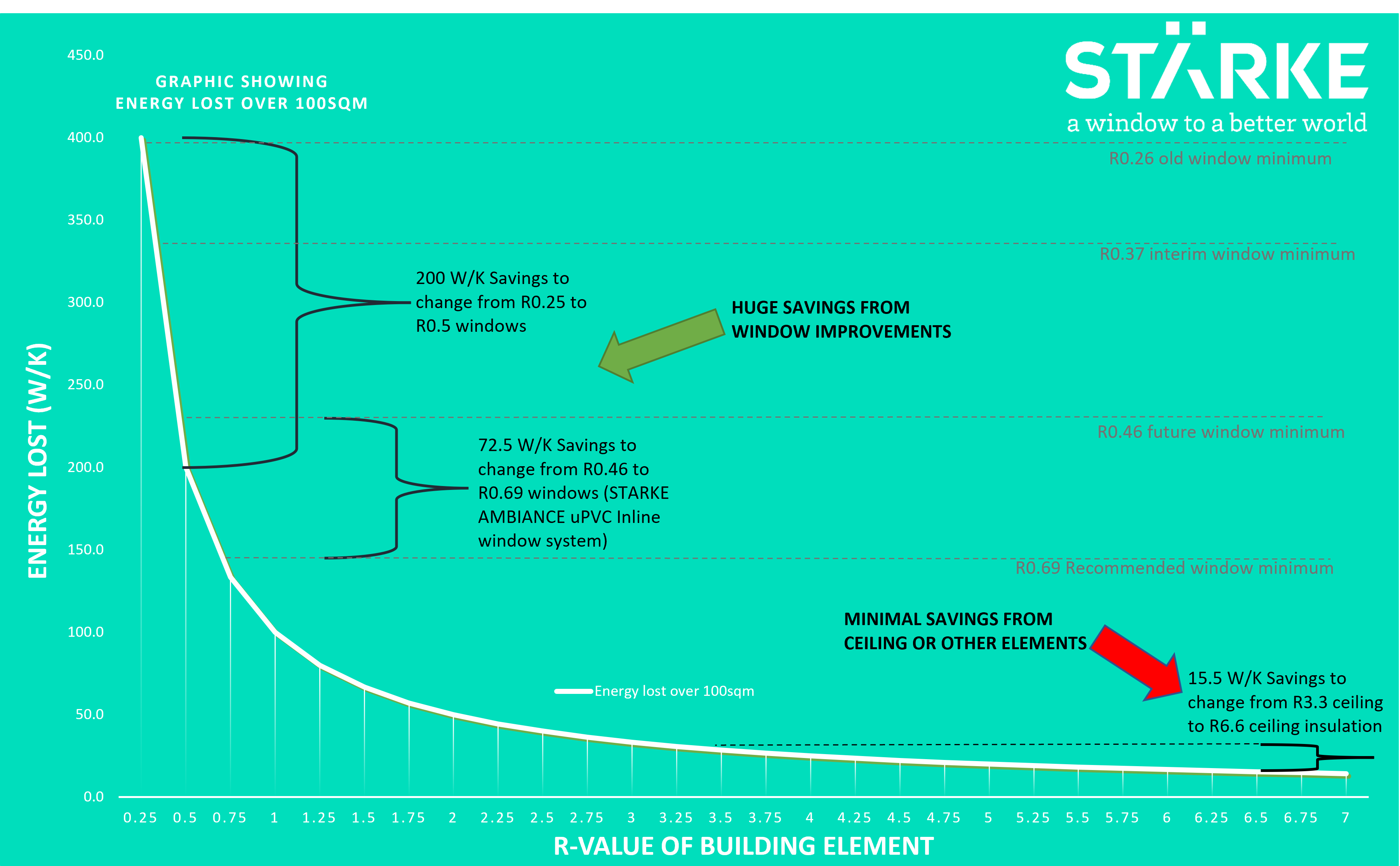When it comes to H1 Compliance, by far the greater energy savings are possible from the worst performing elements. This seems obvious, right?
Ok, answer me this then; if you could increase either your roof or your windows by R0.01, would it make a difference which one you chose?
Most people think the logical answer is that it’d make no difference – R values are R values, no matter where they are!
That couldn’t be further from the truth – changing your windows from R0.26 to R0.27 (a small change) is around 70 times more energy efficient than increasing your ceiling insulation from R6.5 to R6.6.
Which is why smart designers know that specifying the best windows you possibly can is the cheapest way to build. Yes, you’ll pay a little more for windows. But because of the huge savings possible from the worse elements, specifying good windows does all the heavy H1 Compliance lifting for you, leaving the rest of your building envelope performing approximately as it was.
(This blog assumes you have a basic knowledge of how the code works; if you want a refresher, please read through our other blogs here. Also note that this blog covers H1/AS1 (Acceptable Solution). There are other methods of demonstrating H1 Compliance without using an acceptable solution, but these are rare.)
OK, wow. So I don’t necessarily need R6.6 in my ceiling for H1 compliance then?
No, you most certainly do not, if you’re using the calculation or modelling method, which you can easily do for free. For a refresher on the three different methods, please see our blog Bad, Better, Best – H1 Compliance Methods
The below graph shows why this is – improving your window values saves you a huge amount of energy lost, because windows are such bad performers. Increasing your ceiling insulation saves you only a small amount, because most of that heat loss is already being stopped.
This is why the smart designers, architects and engineers are meeting their H1 compliance by just significantly changing one number. Of course, we always recommend exceeding the code, but this is where the bang for buck is.

OK, can I have an example?
Sure. The rule is that energy savings get exponentially less effective as the R-values increase.
As a worked example, changing the R values of 100sqm of windows from R0.26 to R0.27 will result in savings of 14.2 W/K from 384.6 W/K to 370.4W/K
However, making the same change to your ceiling insulation from R6.5 to R6.6 will result in almost no change – a savings of 0.2W/K from 15.4 to 15.2 W/K
That’s confusing for some, because you’d think that adding 0.01 of an R-value would count no matter where you put it. That is not true at all. It counts much more if you put it where the heat is leaking out.
Right, the graph helps I guess… that gives my design freedom back!
What is means is that for many builds, you can keep your walls, roof and ceiling all the same as you have been – and specify the best windows possible, via the calculation method. This improvement in windows makes such a huge difference that it swallows up all the improvements you’re likely to see from any improvements you could make elsewhere in the envelope.
Calculation method is MUCH easier than you thought – thanks to the wonderful online tool here, https://nzgbc.h1calculator.org.nz/. And there are others, too. You just need a few basic numbers, pop them into the calculator, and Voila! You can then save as a PDF and submit to council with your plans. Alternatively, you can send your plans and data to us at sales@starke.co.nz, and we can do it for you.
So I can take advantage of this immediately, before I go and re-design everything?
Immediately. And yes, you should. Below is the range of values we recommend playing with – remembering that you only need to change ONE number, the window number.
You have been used to using R0.26 windows. CHANGE THAT NUMBER.
STARKE AMBIANCE with recommended Low-E – R0.74
Then, head over to STARKE Ambiance uPVC to learn about the product, or our Specifiers Portal for all the drawings. Tried, true, tested and approved, the STARKE AMBIANCE Inline uPVC window system is the future of joinery in New Zealand.
| Configuration | R-Value | Notes |
|---|---|---|
| STÄRKE 35 Cold Aluminium with Clear DG | 0.26 | Below schedule code minimum |
| STÄRKE 35 Cold Aluminium with good Low-E | 0.37 | Below schedule code minimum |
| STÄRKE Ambiance uPVC with Clear DG | 0.44 | Below schedule code minimum |
| STÄRKE Ambiance uPVC with entry-level Low-E | 0.58 | Cost-effective |
| STÄRKE Ambiance uPVC with recommended Low-E | 0.74 | Recommended |
| STÄRKE Ambiance uPVC best performance | 0.91 | Triple Glazing |
OK, great…! What’s next?
Please send your plans to sales@starke.co.nz, and let us know the below (if known)… and we’ll do the rest!
- Thermal performance requirement of the building – ie. code minimum, Homestar, low-energy building, Passive House etc.
- Preferred Compliance Method
- Project dates & timelines
- Estimated joinery budget
- Anything else out of the ordinary on the project we should know about!


